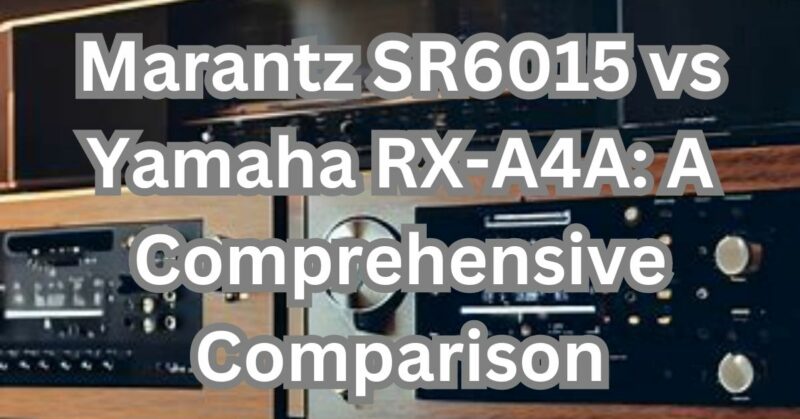When it comes to high-quality audio equipment, Marantz and Yamaha have long been regarded as industry leaders. In this article, we will delve into a detailed comparison between two of their flagship AV receivers: the Marantz SR6015 and the Yamaha RX-A4A. These receivers offer an array of features and cutting-edge technologies to enhance your home theater experience. Whether you are an audiophile or a movie enthusiast, understanding the similarities and differences between these models will help you make an informed decision. Let’s explore the key aspects of both receivers and see how they stack up against each other.
Design and Build Quality
Starting with the design, both the Marantz SR6015 and the Yamaha RX-A4A feature sleek and modern aesthetics. The Marantz receiver boasts a classic look with its black aluminum front panel, while the Yamaha model showcases a more contemporary appearance with its clean lines and brushed metal finish. Both units are well-built and offer a sturdy construction, ensuring durability and longevity.
Audio Performance
When it comes to audio performance, both the Marantz SR6015 and the Yamaha RX-A4A deliver exceptional sound quality. The Marantz SR6015 is equipped with 9 channels of amplification, capable of delivering 110 watts per channel. It supports various audio formats, including Dolby Atmos and DTS:X, creating a three-dimensional soundstage for an immersive experience. The Yamaha RX-A4A, on the other hand, offers 11 channels of amplification with a power output of 150 watts per channel. It utilizes Yamaha’s renowned Cinema DSP technology to enhance the audio experience, providing precise sound localization and room correction capabilities.
Connectivity and Features
Both receivers offer a wide range of connectivity options and advanced features to cater to diverse home theater setups. The Marantz SR6015 provides a comprehensive set of inputs and outputs, including multiple HDMI ports, analog and digital audio inputs, and Wi-Fi and Bluetooth connectivity. It also supports eARC (enhanced Audio Return Channel) and ALLM (Auto Low Latency Mode), ensuring seamless integration with modern TVs and gaming consoles.
The Yamaha RX-A4A also offers an impressive array of connectivity options, with multiple HDMI inputs and outputs, as well as analog and digital audio connections. It supports Wi-Fi, Bluetooth, and Apple AirPlay 2 for wireless streaming and can be integrated with Yamaha’s MusicCast multi-room audio system for whole-home audio distribution.
User Interface and Control
The Marantz SR6015 features an intuitive user interface, with a graphical on-screen display and a user-friendly remote control. Additionally, it is compatible with the Marantz Remote App, allowing users to control the receiver from their smartphones or tablets. The Yamaha RX-A4A offers a similar level of convenience, with an intuitive on-screen display and a dedicated remote control. It also supports Yamaha’s AV Controller App, enabling users to control and customize the receiver’s settings through their mobile devices.
Price and Value
In terms of pricing, the Marantz SR6015 tends to be slightly more affordable compared to the Yamaha RX-A4A. However, both receivers provide excellent value for the features and performance they offer. It ultimately comes down to personal preferences and specific requirements.
Conclusion
The Marantz SR6015 and the Yamaha RX-A4A are two impressive AV receivers that cater to different audio enthusiasts. While the Marantz SR6015 excels in its audio precision and immersive soundstage, the Yamaha RX-A4A offers additional channels and advanced audio processing technologies. Both models provide extensive connectivity options and user-friendly interfaces. When choosing between them, it’s crucial to consider factors such as your specific audio setup, preferred audio formats, and budget.
If you prioritize a refined audio experience and appreciate the finer details in sound reproduction, the Marantz SR6015 is an excellent choice. Its 9-channel amplification, compatibility with Dolby Atmos and DTS:X, and support for eARC and ALLM make it ideal for creating a captivating and immersive home theater environment. The Marantz brand is synonymous with high-quality audio, and the SR6015 lives up to that reputation.
On the other hand, if you desire an even more expansive soundstage and have a larger room to fill with audio, the Yamaha RX-A4A with its 11-channel amplification and Yamaha’s Cinema DSP technology is worth considering. The RX-A4A’s ability to leverage room correction and sound localization techniques allows for precise audio placement and optimization, resulting in a truly immersive listening experience.
When it comes to connectivity and features, both receivers offer a comprehensive set of options. The Marantz SR6015 and Yamaha RX-A4A provide ample HDMI ports, support for wireless streaming, and compatibility with popular control apps. Your decision may come down to personal preferences regarding the user interface and control options offered by each brand.
In terms of pricing, the Marantz SR6015 generally offers a slightly more affordable option compared to the Yamaha RX-A4A. However, it’s essential to evaluate the overall value and features that align with your specific needs. Both receivers offer exceptional performance and quality, making them worthwhile investments for any home theater enthusiast.
In conclusion, choosing between the Marantz SR6015 and the Yamaha RX-A4A depends on your specific requirements and preferences. Whether you prioritize a refined and immersive audio experience or seek a larger soundstage with advanced audio processing, both receivers deliver outstanding performance. Consider factors such as audio formats, room size, desired features, and budget when making your decision. Whichever receiver you choose, rest assured that both Marantz and Yamaha have a long-standing reputation for producing top-notch audio equipment that will elevate your home theater to new heights.


